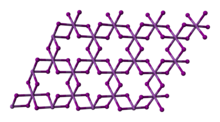Scandium chloride

| |

| |
| Names | |
|---|---|
| IUPAC name
Scandium(III) chloride
| |
| Other names
scandium chloride
scandium trichloride | |
| Identifiers | |
3D model (
JSmol ) |
|
| ChemSpider | |
ECHA InfoCard
|
100.030.714 |
PubChem CID
|
|
RTECS number
|
|
| UNII | |
CompTox Dashboard (EPA)
|
|
| |
| |
| Properties | |
| ScCl3 | |
| Molar mass | 151.31 g/mol |
| Appearance | grayish-white crystals |
| Density | 2.39 g/mL, solid |
| Melting point | 960 °C (1,760 °F; 1,230 K)[1] 63 °C (hexahydrate) |
| 70.2 g/100 mL | |
| Solubility in other solvents | soluble in alcohol, glycerin ]
insoluble in EtOH[citation needed |
| Hazards | |
| Occupational safety and health (OHS/OSH): | |
Main hazards
|
irritant |
| NFPA 704 (fire diamond) | |
| Lethal dose or concentration (LD, LC): | |
LD50 (median dose)
|
3980 mg/kg (mouse, oral) |
| Safety data sheet (SDS) | External MSDS |
| Related compounds | |
Other anions
|
|
Other cations
|
Yttrium(III) chloride Lutetium(III) chloride |
Related compounds
|
Scandium(III) nitrate
|
Except where otherwise noted, data are given for materials in their standard state (at 25 °C [77 °F], 100 kPa).
| |
Scandium(III) chloride is the
Structure
ScCl3 crystallises in the layered BiI3 motif, which features octahedral scandium centres.[3] Monomeric ScCl3 is the predominant species in the vapour phase at 900 K, the dimer Sc2Cl6 accounts for approximately 8%.[4] The electron diffraction spectrum indicates that the monomer is planar and the dimer has two bridging Cl atoms each Sc being 4 coordinate.[4]
Reactions

ScCl3 is a Lewis acid that absorbs water to give
Reduction
Scandium(III) chloride was used by Fischer et al. who first prepared metallic scandium by
ScCl3 reacts with scandium metal to give a number of chlorides where scandium has an oxidation state <+3, ScCl, Sc7Cl10, Sc2Cl3, Sc5Cl8 and Sc7Cl12.[2][9] For example, reduction of ScCl3 with scandium metal in the presence of caesium chloride gives the compound CsScCl3 which contain linear chains of composition ScIICl3−, containing ScIICl6 octahedra sharing faces.[10]
Uses
Scandium(III) chloride is found in some
References
- ^ Frederikse, H.P.R.; Lide, David R. (1998). CRC Handbook of Chemistry and Physics (78th Edition)
- ^ ISBN 978-0-08-037941-8.
- ^ doi:10.1039/a803339k
- ^ The Rare Earth Elements, Fundamentals and Applications
David A. Atwood, 2012, John Wiley & Sons Inc, ISBN 9781119950974
- .
- .
- .
- ISSN 0020-1669.
- ^ Metal Suppliers Online. (2000). Scandium Chloride

